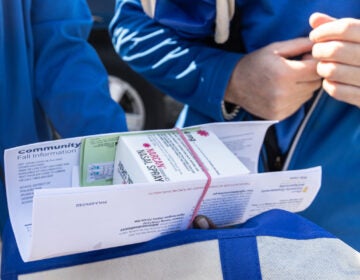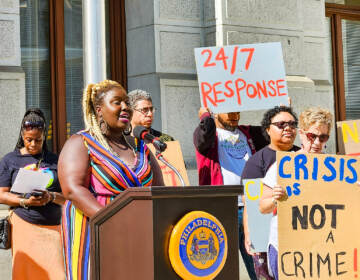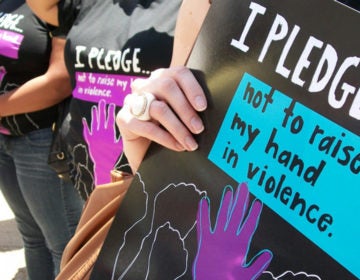Conrail cleanup challenge: helping Philly heroin users into treatment
Listen 6:29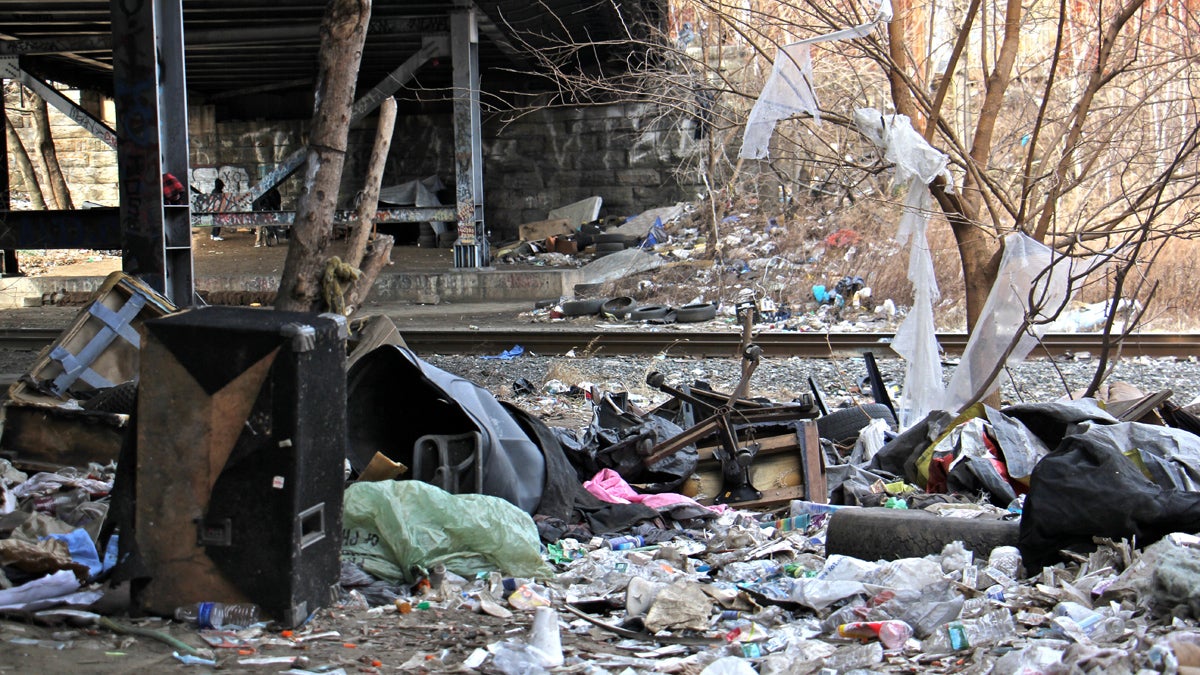
The City of Philadelphia and Conrail will work together to clean and secure the Conrail property in the Fairhill-Kensington neighborhood long used as a campground for drug addicts. (Emma Lee/WHYY)
Dominic Taraborrelli’s house on Tusculum Street faces ground zero of Philadelphia’s heroin epidemic.
Weeds and bushes obscure his view of the Conrail tracks that run alongside the street, but he said he doesn’t have to be able to see the encampment of drug users along the tracks to witness the trauma of addiction.
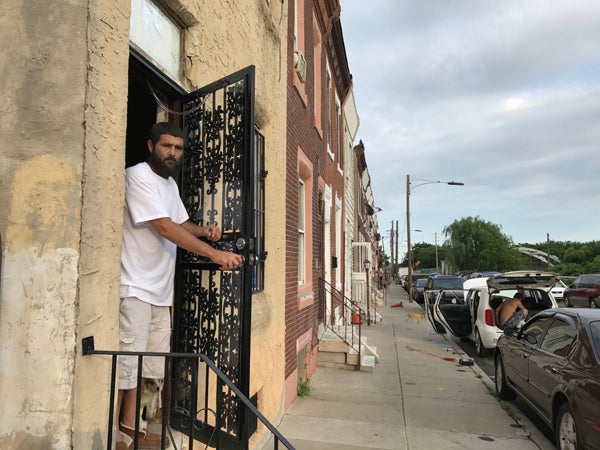
Police carry the limp bodies of overdose victims up the slope on a routine basis. The latest casualty came up the day before, he said, at the corner of the block where a bridge passes over the railroad gulch.
“They pulled him up,” Taraborrelli said. “It was about 8 o’clock in the morning.”
The 43-year-old Taraborrelli was raised in the house where he now lives with his wife and three sons. He said he’s had to deal with the hazards of living alongside a haven for heroin use for over 30 years.
Taraborrelli said he constantly reminds his kids to be careful when they go outside.
“There’s needles through the whole entire block,” he said.
The city reports that 17 people died of overdoses around the tracks last year, and another 29 were rescued by emergency responders.
Taraborrelli hopes that a coordinated effort by the City and Conrail to clear out the longstanding encampment in the Kensington section of Philadelphia will finally bring peace to his block. The work is due to begin by Monday July 31, according to an agreement signed last month. Conrail will clean up tons of tires and debris, remove hundreds of thousands of dirty needles and clear-cut the vegetation that hides drug activities along the half-mile stretch of tracks. In advance of the cleanup, it’s been installing new fencing to make sure people don’t return once the work is done.
But the community of about 75 homeless people struggling with heroin addiction — and many more who go down to the tracks to shoot up — will have to go somewhere once the work begins.
“While we do this cleanup, and we bring out of the element something that for a long time has been contained, it’s going to be more disruptive,” said Maria Quiñones-Sánchez, a city councilwoman whose district includes the encampment.
Will it just move the problem?
Many worry that the population of heroin users will simply spread out to other pockets of a neighborhood that’s already known for being an open-air drug market. The city is trying to help as many of them as it can, but some say their efforts are falling short.
When city officials announced the cleanup plan with Conrail last month, they detailed the resources the city would be dedicating to the human side of the project.
They’ve set up a 23 bed emergency shelter at nonprofit partner Prevention Point Philadelphia, and have 35 permanent housing slots reserved for people coming from the area.
But workers for the Office of Homeless Services counted 78 people living in the camp at the beginning of May according to Liz Hersh, the agency’s director. Outreach teams ramped up efforts around the Conrail tracks that month to offer housing and treatment services.
The population dropped more recently as word spread about the cleanup, but as of the end of June only nine people had accepted help from outreach workers.
These numbers worry advocates like Prevention Point’s executive director, Jose Benitez. He said that the new resources won’t be enough, and that barriers in the city’s treatment system make it difficult to serve people who are interested in getting help.
“We just don’t have capacity,” Benitez said. “There’s not enough beds or treatment slots to be able to handle the folks that are going to come out of there. Those are 75 people, we think, that are homeless, that we’re evicting from their homes.”
Hard to keep up with demand for treatment
Prevention Point recently hosted a town hall meeting on the opioid crisis inside the former church in Kensington where the organization is located. Fans were running on full blast in the sanctuary on a hot and sticky evening, but people packed the pews for a dialogue with city representatives.
Many of them eagerly lined up for a chance to comment on a presentation about the city’s response to the crisis. One commenter drew attention to an apparent shortage of slots for medication assisted treatment, which uses drugs such as methadone or Vivitrol to manage cravings and withdrawal symptoms.
While the city estimates there are about 70,000 heroin users in Philadelphia, it provides roughly only 7,000 treatment slots for medication-assisted treatment. Overall, the city’s publicly-funded system treated about 14,000 people for opioid addiction last year.
Some attendees of the meeting said it takes too long to start treatment once people reach out for help. Luke Patrick Dunn, who is in recovery, said some people are discouraged from seeking help because of the wait times for getting medication-assisted treatment. He went into withdrawal when he first went to an intake center to sign up for treatment.
“You might get hung up in one of those places for like two to three days,” Dunn said. “And you give up, because you get sick, you know?”
Dunn was homeless in Kensington before landing a slot 15 months ago in a program called Journey of Hope. He said the long-term housing provided by the program has allowed him to get back on his feet. He’s about to move into an apartment of his own and has a job doing outreach for Prevention Point.
Another peer outreach worker at the church that evening, Ramon Cruz Jr., said he had been working with people at the Conrail encampment. The problem for most of them, Cruz said, isn’t accessing treatment — it’s getting stable housing to keep them in recovery.
“They have been getting treatment, but then they come back out and they have no housing,” he said. “So they go back to what they know best, and it’s a continual cycle.”
Cruz, who lives in Kensington, said you can already see drug users migrating to new spots as Conrail puts up new fencing.
“We have some people that are under the bridge at Emerald Street, we have some people under the bridge at Aramingo,” he said.
The city said it will find more treatment beds for people from the camp if it reaches capacity. But many aren’t yet willing to accept help.
Prevention Point’s Benitez said that more people at the Conrail tracks might be motivated for change once cleanup work begins and heavy machinery moves into the area.
“But I also caution that there are always going to be people who are not ready for the services we have to offer them,” Benitez said.
He said it takes time to earn their trust. Ultimately, says Benitez, that trust will depend on whether those offering treatment can follow through on their promises.
WHYY is your source for fact-based, in-depth journalism and information. As a nonprofit organization, we rely on financial support from readers like you. Please give today.


